Not a pollster was stirring, not even Patrick Gower’s pet mouse.
Okay, enough of that silliness, I have been too busy to write detailed thoughts on politics, but I HAVE been busy graphically explaining even more of the state of play on social media.
We now appear to have had the two final polls of election season, thus I feel relatively confident giving you the average results and the final results of the two major New Zealand polls. (Unlike some, I believe Roy Morgan is roughly as reliable as Reid Research’s/Newshub’s poll and Colmar Brunton’s/TVNZ’s one, it’s just done so infrequently that it’s not sufficently up to date now to be of use)
 Let’s start by comparing the base seats we would expect to see in both of the major polls.
Let’s start by comparing the base seats we would expect to see in both of the major polls.
The Colmar Brunton narrowly paints Peters below the Party vote threshold. (until you consider the margin of error, where he potentially comes back in with a 52.3% probability over 2,000 simulations) I’ve been pretty strict that I haven’t assumed the Greens will win Nelson or that NZF will retain Northland, as the polling shows a small but significant gap in Nelson, and Northland was taken from the Government in a by-election. I imagine Peters 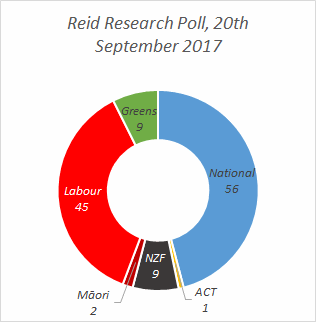 is capable of winning it on his own merits now as he is an incumbent, but assuming those things without a poll to back it up makes me very uncomfortable, and nobody polled Northland or Ilam this election, and these could reasonably be assumed to be key electorates. This scenario is a hung Parliament, assuming it is dead-on, (and of course, it won’t be) but once you factor in the margins of error, there are probably a lot more ways for a left-wing coalition to win than a right-wing one, as there are more ways for them to have been underestimated, if Peters did end up losing his electorate and below threshold.
is capable of winning it on his own merits now as he is an incumbent, but assuming those things without a poll to back it up makes me very uncomfortable, and nobody polled Northland or Ilam this election, and these could reasonably be assumed to be key electorates. This scenario is a hung Parliament, assuming it is dead-on, (and of course, it won’t be) but once you factor in the margins of error, there are probably a lot more ways for a left-wing coalition to win than a right-wing one, as there are more ways for them to have been underestimated, if Peters did end up losing his electorate and below threshold.
The Reid Research poll shows Peters’ party in coequal status with the Greens, and likely required for either side to form a coalition. If NZF abstains in this scenario, National can then govern, but every bill would require either NZF support or at least the Greens to cross the floor. That’s a very unstable arrangement, meaning either a National-NZF or Labour-Green-NZF coalition would be required if this poll is bang on.
But again, that doesn’t really give us the full picture. Let’s look at margins of error: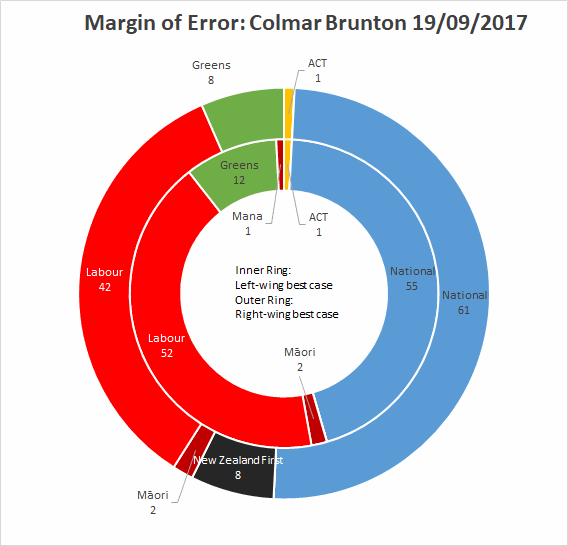
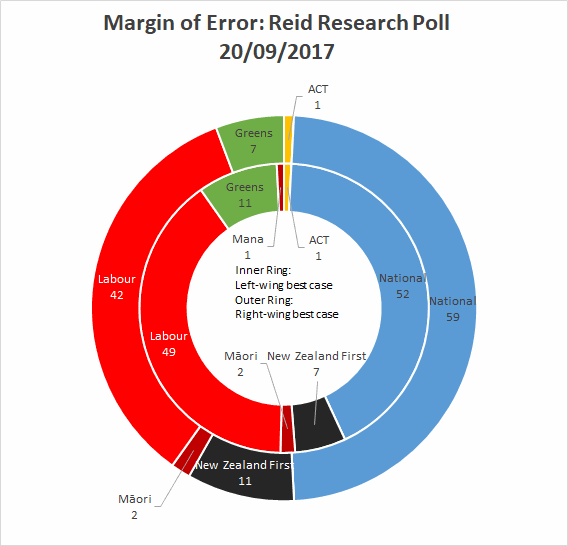
These double-ring graphs, or nested donuts, show us the bounds of each coalition arrangement. A coalition can govern if they make it past the bottom centre of the inner or outer ring. As no coalitions pass the centre in both rings, nobody is expected to govern outright. I have placed a stronger NZF in National’s bloc because that generally favours them more in forming a government, but they have of course expressed no clear preference, so should be viewed as a wild card. These scenarios are all four of them highly unlikely. In reality, the edges of the margin of error are so far out from normal statistical polling that lining them all up together like this is even less likely than the poll itself being rogue and some of the results being outside of those margins. To get a better idea about what these polls mean, we need to run simulations.

These graphs represent a lot more obscured work than the other two, which are just me plugging single-poll stats into the override column on my averaging spreadsheet.
The Colmar Brunton one represents 400 simulated elections, and what share of them each grouping “won.” I omit ACT from the National scenario’s name, but they are there in some of the outcomes. (I do allow for a 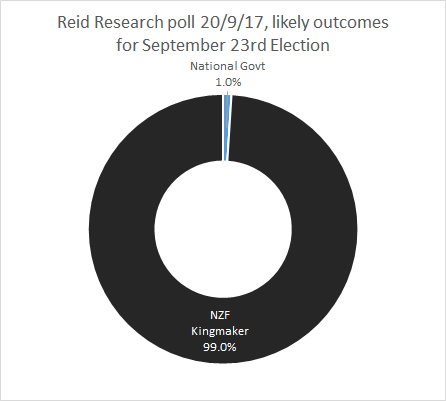 chance for ACT or the Māori party to lose electorates, and even for Mana to win Te Tai Tokerau)
chance for ACT or the Māori party to lose electorates, and even for Mana to win Te Tai Tokerau)
And the appalling circle of black doom on my right is a collection of 1,000 simulations, (I made it easier to do more as I went along) of which precisely four are too small to show and rounded out of the results, with 2 Māori Party governments showing up on the very edge, and 2 “crossovers” where either the Māori Party must work with National and NZF and maybe ACT, or NZF must work with Labour, the Greens, and the Māori party and maybe MANA, or one of the two has to abstain in order for Parliament not to be hung.
 I have a healthy amount of skepticism about the changes to Reid Research’s poll methodology and the addition of online panels. While the two last results were superficially a bit similar, both the one-off Horizonpoll and Reid Research have been friendlier to National and New Zealand First than the other polls. It’s difficult to fairly compare Horizon without past results, but taken with its commonality with the two most recent Reid Research polls in showing either National or New Zealand First at unexpectedly high
I have a healthy amount of skepticism about the changes to Reid Research’s poll methodology and the addition of online panels. While the two last results were superficially a bit similar, both the one-off Horizonpoll and Reid Research have been friendlier to National and New Zealand First than the other polls. It’s difficult to fairly compare Horizon without past results, but taken with its commonality with the two most recent Reid Research polls in showing either National or New Zealand First at unexpectedly high
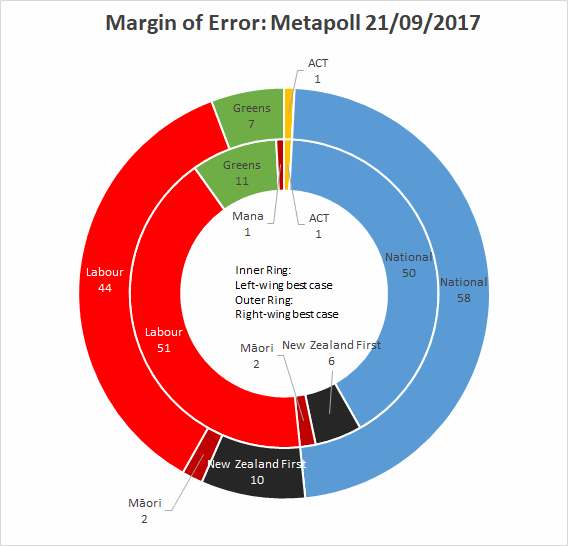 So that covers the last two polls. The average is, as you’d expect, somewhere between them, with a little weirdness thrown in from using the older polls to moderate them a little bit. When looking at the average we should consider the trend of the most recent polls, which both agree that Labour is dropping a bit, National is not as high as the two latest polls suggest, although maybe higher than the average does, that the Greens are rising, however they are in sharp disagreement about whether NZF is rising or falling, however not to the level where we can be sure the reality isn’t simply that they stayed still or rose very slowly from 6% to, say, 6.2%.
So that covers the last two polls. The average is, as you’d expect, somewhere between them, with a little weirdness thrown in from using the older polls to moderate them a little bit. When looking at the average we should consider the trend of the most recent polls, which both agree that Labour is dropping a bit, National is not as high as the two latest polls suggest, although maybe higher than the average does, that the Greens are rising, however they are in sharp disagreement about whether NZF is rising or falling, however not to the level where we can be sure the reality isn’t simply that they stayed still or rose very slowly from 6% to, say, 6.2%.
I went a bit overboard for the simulations and did 2,000, just to be really sure, so there should be a fair approach there to decently representing the probability of what kind of Parliament we see after Saturday’s count comes in. I don’t pretend to know for sure exactly how the specials will bump things once they’re counted, but they have in the past tended to lose National a seat and gain the Greens one, and many young people registered during advance voting, which was newly available this year, and cast special votes at the same time, which might suggest that Labour will also start doing well in the specials.
 While it’s often said of the minor parties that NZF routinely underpolls and Greens routinely overpoll, this is not exactly true. What tends to happen is that NZF has an upward trend that may be explained purely in lag between the poll and changes in attitude of voters on election day, while the Greens are usually in a downwards trend on election day that might also continue. This year, NZF had been in a downwards trend until the very last poll, and the Greens were in a consistent upward trend, although all three big polling organisations disagreed as to how much. I wouldn’t be surprised if we see NZF poll at somewhere around 5-6%, and the Greens poll between 7-8%, but it’s possible that the saying really is true and we will see the reverse trend.
While it’s often said of the minor parties that NZF routinely underpolls and Greens routinely overpoll, this is not exactly true. What tends to happen is that NZF has an upward trend that may be explained purely in lag between the poll and changes in attitude of voters on election day, while the Greens are usually in a downwards trend on election day that might also continue. This year, NZF had been in a downwards trend until the very last poll, and the Greens were in a consistent upward trend, although all three big polling organisations disagreed as to how much. I wouldn’t be surprised if we see NZF poll at somewhere around 5-6%, and the Greens poll between 7-8%, but it’s possible that the saying really is true and we will see the reverse trend.
Overall, it’s likely to be a close election, and there is a small possibility of Labour eking out a government if the polls haven’t been underestimating them and their potential partners, but it will need a large shift back from New Zealand First’s apparent recent gains if that is to be the case.
To everyone who hasn’t yet enrolled to vote, or is not yet sure they’re enrolled, you have until your nearest advance voting place closes to enroll, or until midnight if you want to enroll online and then cast a special vote on election day. (this may be easier if you are working and your advance voting place does not stay open late, as your employer is legally required to give you a reasonable amount of leave to vote if you work on Saturday)
Good luck voting on election day. Due to our weirdly restrictive laws, I won’t be able to post anything too political until polls close, (I can currently tell you that I voted both ticks for the Greens, assuming you didn’t ask me before I told you, but I couldn’t have said that on election day!) even though New Zealenders overseas almost certainly will be taunting us on social media, and an amount of us comparable to the combined support of the Labour and Green parties added together have already voted despite us advertising, exhorting, and persuading them throughout the entire period. Presumably before the next election, we may need to think about putting some light restrictions on the advance voting period that aren’t there now, and lifting many heavy restrictions currently on election day, especially the bans from individuals who aren’t candidates talking to each other on social media.
Another final thing that bears amplifying is that some people have reported Electoral staff are giving incorrect information to Māori voters, telling them there are certain independent Māori parties they can’t vote for if they’re on the general roll, (they are not allowed to even discuss what parties you might vote for, and the only time they should talk about whether you can is if they’re reassuring you every party on your ballot is a valid choice) or trying to give voters on the Māori Roll ballots for a general electorate, or failing to identify voters on the general roll and so assuming they are not enrolled at all, or directing them to put the correct ballot for their electorate in the wrong ballot box for a different electorate. That last one is a small error, as it is generally rectified when a polling place’s ballots are counted, as counters confirm all ballots do belong in the box they were submitted to, and simply move them to another pile if not. But the first two errors could potentially persuade voters to change their party vote or disqualify their vote altogether, which is a Really Big Deal. Anyone who might be identified, correctly or incorrectly as Māori, will hopefully be aware of what their correct electorate is, which roll they are registered on, that like everyone else they don’t need ID or an easyvote card in order to vote, and that once you’ve confirmed you have the ballot for the correct electorate, all options in each column are valid to be ticked once.
Good luck to everyone who hasn’t yet voted. Your Party Vote is the more important of the two to how Parliament shapes up, but your electorate vote is also relevant, especially if you live in any of the Māori electorates, in Ilam, Northland, Nelson, or Epsom, with those last two being three-way races. Ilam could return an independent, Northland could retain Peters, Nelson could see the second ever Green electorate MP, and while Epsom has a healthy lead for David Seymour, he is by far one of the worst MPs in Parliament, and if he wasn’t being thrown a safe seat by national repeatedly, would likely be gone by now.
